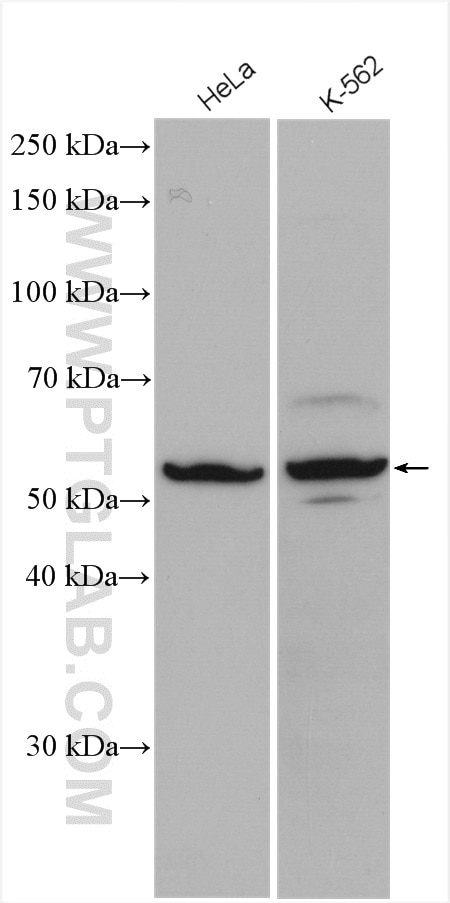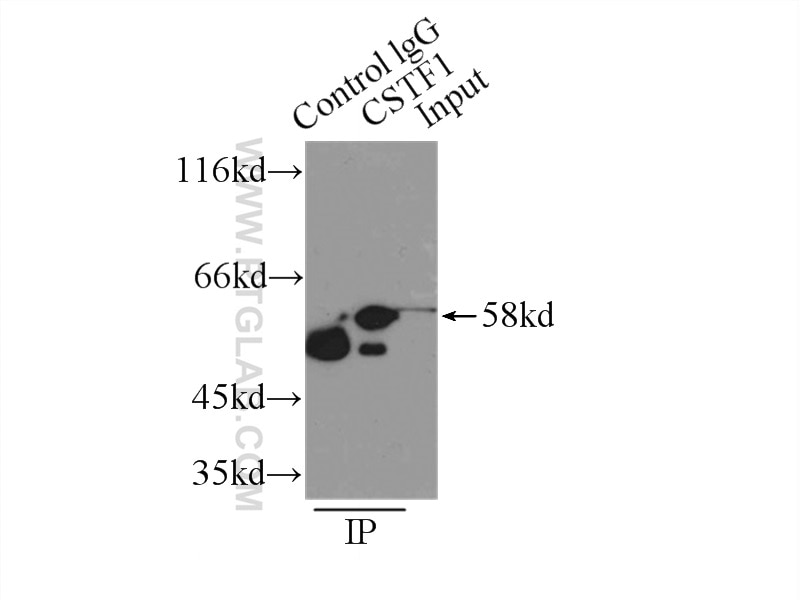CSTF1 Polyklonaler Antikörper
CSTF1 Polyklonal Antikörper für WB, IP, ELISA
Wirt / Isotyp
Kaninchen / IgG
Getestete Reaktivität
human, Maus, Ratte
Anwendung
WB, IP, ELISA
Konjugation
Unkonjugiert
Kat-Nr. : 10064-2-AP
Synonyme
Geprüfte Anwendungen
| Erfolgreiche Detektion in WB | HeLa-Zellen, K-562-Zellen |
| Erfolgreiche IP | NIH/3T3-Zellen |
Empfohlene Verdünnung
| Anwendung | Verdünnung |
|---|---|
| Western Blot (WB) | WB : 1:500-1:1000 |
| Immunpräzipitation (IP) | IP : 0.5-4.0 ug for 1.0-3.0 mg of total protein lysate |
| It is recommended that this reagent should be titrated in each testing system to obtain optimal results. | |
| Sample-dependent, check data in validation data gallery | |
Veröffentlichte Anwendungen
| WB | See 5 publications below |
Produktinformation
10064-2-AP bindet in WB, IP, ELISA CSTF1 und zeigt Reaktivität mit human, Maus, Ratten
| Getestete Reaktivität | human, Maus, Ratte |
| In Publikationen genannte Reaktivität | human, Maus, Ratte |
| Wirt / Isotyp | Kaninchen / IgG |
| Klonalität | Polyklonal |
| Typ | Antikörper |
| Immunogen | CSTF1 fusion protein Ag0109 |
| Vollständiger Name | cleavage stimulation factor, 3' pre-RNA, subunit 1, 50kDa |
| Berechnetes Molekulargewicht | 48.3 kDa |
| Beobachtetes Molekulargewicht | 50 kDa |
| GenBank-Zugangsnummer | BC001011 |
| Gene symbol | CSTF1 |
| Gene ID (NCBI) | 1477 |
| Konjugation | Unkonjugiert |
| Form | Liquid |
| Reinigungsmethode | Antigen-Affinitätsreinigung |
| Lagerungspuffer | PBS with 0.02% sodium azide and 50% glycerol |
| Lagerungsbedingungen | Bei -20°C lagern. Nach dem Versand ein Jahr lang stabil Aliquotieren ist bei -20oC Lagerung nicht notwendig. 20ul Größen enthalten 0,1% BSA. |
Hintergrundinformationen
Cleavage stimulation factor (CstF) , a heterotrimeric protein with subunits of 77, 64, and 50 kD (CstF-77, -64, and -50), is a polyadenylation factor that helps to specify the site of processing. CstF recognizes the G+U-rich element, a sequence located downstream of the cleavage site. CstF-50 subunit interacts with the COOH-terminal domain of the RNAP II largest subunit (CTD). This subunit may be responsible for the interaction of CSTF with other factors to form a satable complex on the pre-mRNA, and multiple WD domains are required for protein interactions.
Protokolle
| PRODUKTSPEZIFISCHE PROTOKOLLE | |
|---|---|
| WB protocol for CSTF1 antibody 10064-2-AP | Protokoll herunterladen |
| IP protocol for CSTF1 antibody 10064-2-AP | Protokoll herunterladen |
| STANDARD-PROTOKOLLE | |
|---|---|
| Klicken Sie hier, um unsere Standardprotokolle anzuzeigen |
Publikationen
| Species | Application | Title |
|---|---|---|
EMBO J The 3' ends of human pre-snRNAs are produced by RNA polymerase II CTD-dependent RNA processing. | ||
Cell Rep LINC00921 reduces lung cancer radiosensitivity by destabilizing NUDT21 and driving aberrant MED23 alternative polyadenylation | ||
Oncogene p53 inhibits mRNA 3' processing through its interaction with the CstF/BARD1 complex. | ||
Andrology Nicotine elevates sperm motility and induces Pfn1 promoter hypomethylation in mouse testis. | ||
iScience Chromodomain helicase DNA-binding domain 2 maintains spermatogonial self-renewal by promoting chromatin accessibility and mRNA stability | ||
Cancer Lett YTHDF1 regulates GID8-mediated glutamine metabolism to promote colorectal cancer progression in a m6A-dependent manner |



